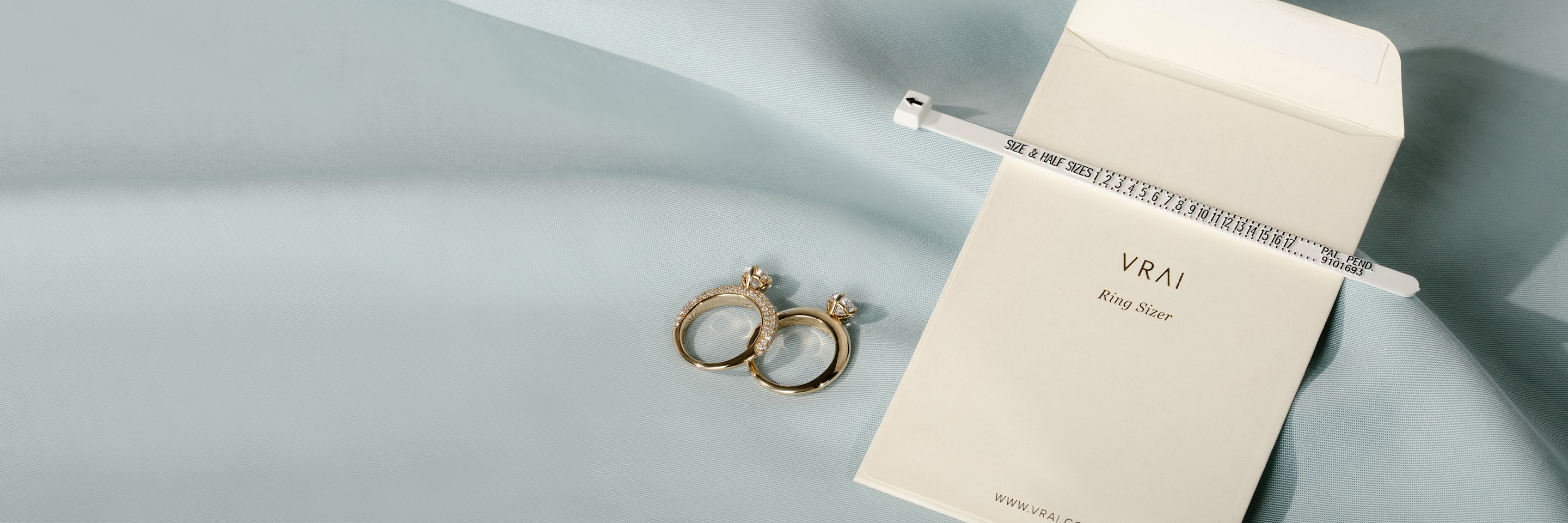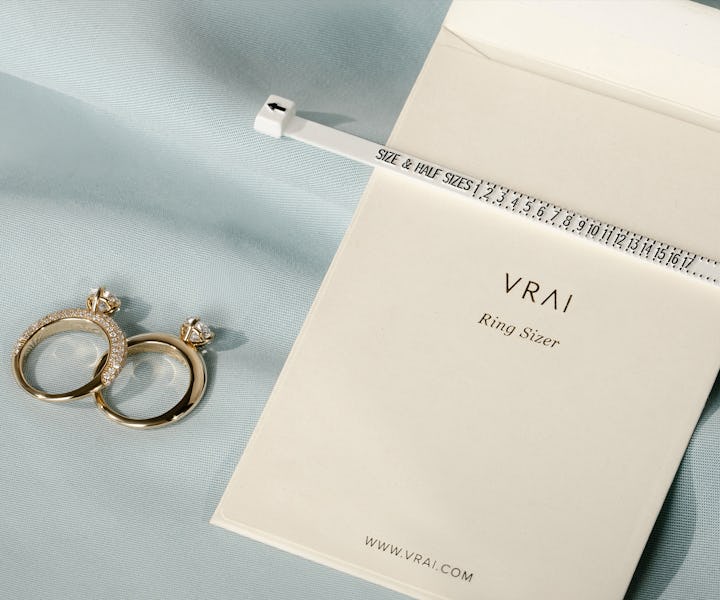

Asscher Cut Diamonds: Ask a Diamond Expert
With its wide step-cut facets and a high crown, the Asscher diamond cut symbolizes opulence and sophistication.
It was a beloved shape in the 1920s and 1930s, and became part of pop-culture history when Richard Burton chose an Asscher engagement ring to propose to Elizabeth Taylor. Engagement rings featuring Asscher VRAI created diamonds marry symmetry, scintillation, and the unique luster of step-cut diamonds.
GIA graduate gemologist Queena Chang and VRAI’s Chief of Sales and CX Grace Taylor sat down to answer some of the most common questions about Asscher diamonds.
What Is an Asscher Cut Diamond?
Asscher diamonds are a type of step-cut diamond. “Step-cut” refers to the type of faceting, which runs parallel to the diamond’s edges, giving it a distinct hall-of-mirrors effect. Emerald and Asscher diamonds share the type of faceting, but Asschers are not just “square emeralds.” They have larger, wider facets compared to the Emerald. The facets running from the corners on both the crown and pavilion that converge at the center create a pattern often referred to as the “windmill.”
The History of the Asscher Cut
Dutch diamond cutter Joseph Asscher of the Asscher family developed the Asscher cut in 1902, making it the first patented signature cut.
In 1908, the Asscher family was commissioned by the Royal family to cut the world’s largest diamond in history, the Cullinan diamond, weighing 3,106 carats. They also cut the Excelsior diamond. In 1980, Queen Juliana of Holland granted the Asscher company the “Royal” prefix, given the leading role they played in the country’s diamond industry. The family business is still in operation to this day.
In 2001, brothers Edward and Joop Asscher, descendants of Joseph, designed and patented the Royal Asscher Cut. Compared to the original Asscher cut with its 58 facets, the Royal Asscher cut has 74 facets.
The Most Famous Asscher Diamonds in History
When the Asschers cut the Cullinan diamond, they created nine major stones. The Cullinan IV, known as the “lesser star of Africa,” is a Square-cut diamond that does, by all means, look like an Asscher cut diamond (notice the windmill pattern) and weighs 63.6 carats.
The Krupp diamond, a stunning 33.19 carat stone, was set in the most well-known Asscher cut diamond ring, which belonged to Elizabeth Taylor. It is now commonly referred to as the Elizabeth Taylor diamond.
How to Buy an Asscher Diamond
“I try to focus on a good color and cut grade first and foremost, but for clarity, I try to focus on VS+,” says GIA graduate gemologist Queena Chang. “Asschers can unfortunately look very flat and dull if the cut is off, so being able to view the diamond and see its light performance would be the most important grade.”
Evaluating Asscher Cut Diamonds
When it comes to buying an Asscher diamond, one needs to take the 4Cs into account, but the importance of each varies by shape.
Cut
While there is no standard cut grading for an Asscher diamond, symmetry and policing still play an important role in the way the Asscher’s cut is graded. Symmetry refers to the alignment of the facets, while polish indicates the degree of smoothness of the facets and the quality of its edges. These grades refer to the skill and expertise of the master cutter, rather than the inherent qualities of the rough diamond.
As for scintillation, one of the most salient selling points for diamonds, “Asscher cuts tend to have wider and larger facets than Emerald cuts, and tend to exhibit more scintillation than Emeralds, giving the Asscher more shine despite sharing the same faceting style,” says Queena Chang, VRAI’s Chief Diamond Expert and a GIA graduate gemologist.
The Asscher diamond also has a higher crown and a smaller table which, in addition to the larger facets, produces more brilliance than the emerald cut. In order for an Asscher to be considered well cut, you have to be able to see concentric squares as you look down through the table, which is indicative of the positioning of the pavilion facets.
Clarity and Color
The larger facets of Asscher diamonds also make clarity characteristics and inclusions more apparent. Chang recommends VS+ clarity. Brilliant-cut facets are triangular and kite-shaped. When a diamond is well cut, they can conceal inclusions, so you can strike luck with SI-grade diamonds. In the case of Asscher cuts, however, the wide, trapeze-shaped facets make inclusions visible, so it’s best to stay on a VS+ clarity diamond.
Just like with clarity, color shows up more easily in Asscher diamonds because of the larger facets. In addition, step cut diamonds tend to trap more body color due to their light return properties.
“For Asschers, both color and clarity are fairly important. They are step cuts, which means larger facets that will do less to hide imperfections in terms of clarity.” echoes Grace Taylor, VRAI’s Chief of Sales and CX. “VS1 is generally a good safety range, with VS2s on a case by case basis. Color can be apparent in asschers as well - if you're opting for a white metal or diamonds surrounding the center stone (halo or three stone, for example), sticking with H+ color is advised.”
Carat
The Asscher diamond holds most of its weight in the pavilion rather than the crown. While this allows for large, elaborate facets that create the coveted hall of mirrors effect, this weight distribution comes to the detriment of the diamond’s size. “The diamond will be more lifted in the setting, which can help with appearing larger,” explains Chang. “Unfortunately, what this does mean is that most of the weight of the diamond is being held at the pavilion, which means that Asschers in general will face up smaller than other cuts of the same carat weight.”
Be the first to know
Hear about our latest designs and upcoming events.
Top 3 Settings for Asscher Diamonds
Given the pristine geometry and clean, symmetric lines created by the faceting pattern of the Asscher, Queena Chang favors three styles to pair with the Asscher diamond that highlight these unique characteristics.
“I love the Cathedral paired with the Asscher, something about the architectural strong lines really jumps out to me,” she said. “The Bezel setting is one of my absolute favorites with the Asscher. In terms of multi-stone options, I quite like the Three stone with Tapered Baguette sides.”
Pros and Cons of the Asscher Cut Diamond
Asscher diamonds are quintessentially elegant diamonds that harken back to the Art Deco era. Their brilliance rivals the one seen in Round Brilliant diamonds. Asschers are stylistically versatile, pairing well with Art Deco style, classic, and modern engagement-ring settings.
Asschers show their true colors, quite literally. So if you want to purchase an Asscher diamond, you cannot compromise on any of the 4Cs. More importantly, unless your diamond has excellent symmetry and polish, it can easily look dull, as the large facets show both color and inclusions. This means you have to get a VS+ clarity grade and a color grade of G or above if you want your diamond to appear as white and scintillating as it can.
In addition, Asschers carry the majority of their weight in the pavilion. For this reason, they will appear smaller than other diamond shapes at the same carat weight. The deep pavilion, on the other hand, requires higher settings, which will, in turn, make the diamond appear larger.
How Big Is an Asscher Diamond on My Hand?
An Asscher appears noticeably smaller than other diamond shapes on a person’s hand. Consider that a 1-carat Round diamond measures 6.5 mm in diameter. At 1 carat, an Asscher diamond only measures between 5.67 and 5.87 in width and length. This means that it will appear between 10 and 15% smaller than a Round diamond at the same carat weight.
For instance, a 1.5-carat Asscher measures around 6.51 mm in length and width, which is the standard measure of a 1-carat Round diamond. At 2 carats, the Asscher is between 7.17 and 7.37 mm, which appears quite small compared to a 2-carat Round, which averages 8.1 mm at 2 carats. All the measurements come from VRAI’s collected data, outlined in VRAI’s Diamond Chart.
VRAI Created Diamonds
VRAI only sells lab created diamonds grown in our certified zero-emission foundries, powered by 100% renewable energy. This means all VRAI created diamonds are no mining, no human toll, no emission, no guilt diamonds. Lab created diamonds are physically, chemically, and optically identical to mined diamonds. This significantly brings down the cost of lab created diamonds giving you more carats for less.



